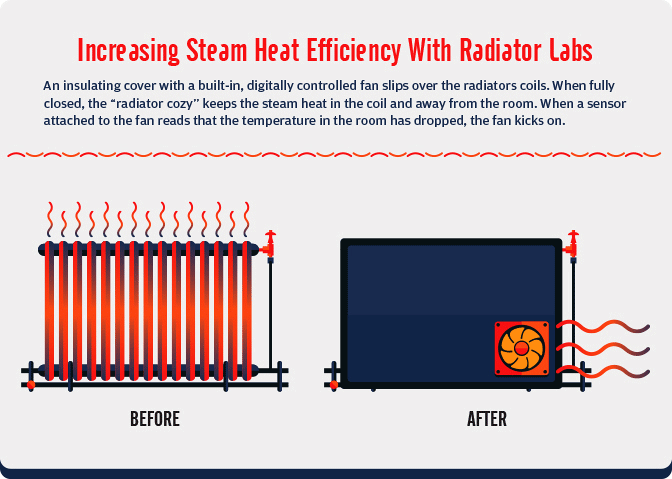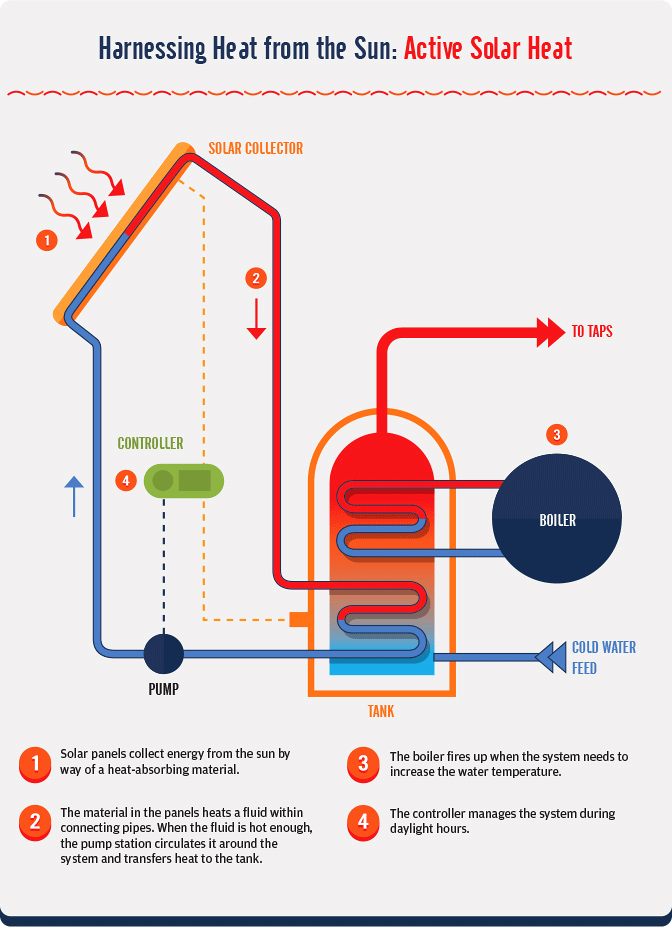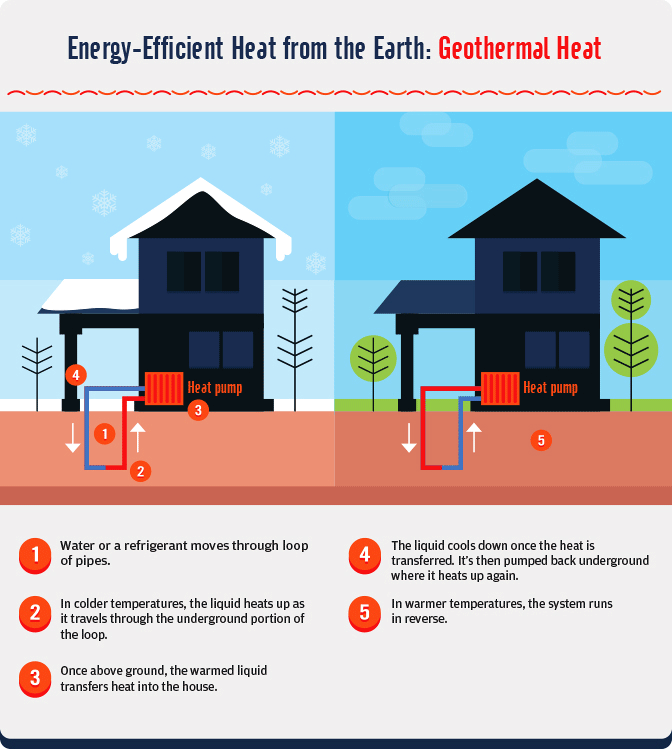Home Heating Tech to Feel Warm, Fuzzy, and Sustainable All Winter Long
Most homeowners only think about their home’s heating system twice: during the winter and when it’s broken. Many homeowners eventually replace what was there when they first moved in. But without a little research on the latest in home heating technology, they could be doing their homes (and their wallets) a disservice. Read on to learn more about technology that nearly always promises to save money in the long run yet doesn’t require a huge, up-front investment.
Though the idea of upgrading an old-fashioned steam radiator in a century-old home may sound unfeasible, new heating systems won’t always cost a fortune (no matter the age of a home).
State-of-the-Art Steam
Steam heating is one of the oldest central heating technologies, and it is still used in older homes and apartments. Steam radiator systems gained popularity because the steam moves itself through a building’s pipes without mechanical pumps, which made the residences less expensive to implement. Unfortunately, the process of boiling and condensing water is inherently energy-intensive, and steam only comes in one temperature: 212 degrees F. For this reason, many 21st century apartment dwellers have been guilty of opening windows in freezing temperatures in an effort to adjust the temperature of a given room. In the process, this forced the steam system to use even more energy.
At a TED Talk in 2012, all of that changed. Marshall Cox, a PhD candidate in electrical engineering at New York’s Columbia University, introduced the world to a simple, highly effective way to improve the efficiency of steam radiators. At the same time, tenants and building owners would have the ability to adjust the temperature in a given room with their smartphones.
How did Cox do it? An insulating cover with a built-in, digitally controlled, quiet fan slips over the radiators coils. When fully closed, the “radiator cozy” keeps the steam heat in the coil and away from the room. When a sensor attached to the fan reads that the temperature in the room has dropped to, say, 72 degrees, the quiet fan kicks on. Steam-heated air blows into the room, and the radiators’ thermostats can be adjusted room by room and even controlled remotely with a proprietary Radiator Labs app.

Source: Fix.com
In a building-wide implementation in New York City, Cox and his team claim the radiator cozies could cut the steam-heating system’s total energy demand by as much as 40 percent. That’s a huge potential savings for homeowners and landlords and a big win for planet Earth, especially because most steam systems are still powered by fossil fuels such as oil and natural gas.
Using fewer fossil fuels is a great step forward, but some homeowners want to go even further and completely eliminate their home’s fossil fuel use altogether. Those homeowners – even the ones with older homes – may be able to benefit from active solar heating.
Solar Heat
Putting solar panels on homes to help generate electricity is a pretty well-known process, but active solar heating is a bit different. In these active systems, the solar energy captured by the panels is used to directly heat a fluid, either liquid or air, and then transfer that heat into the home’s living space when radiators or fans blow heated air through ductwork in the building’s walls.
There are a number of factors that ultimately determine whether or not a specific home or commercial building will be able to switch completely to active solar. However, the climate is probably the most important factor. Homes built farther north, for example, will not only get colder and require more heating but also will receive less sunlight during the winter (limiting the effectiveness of an active solar heating system). The home’s design is a factor to consider when weighing the costs and benefits of solar heating because a two-story building will have twice as much living space to heat as will a single-story home with the same roof.
Despite those limitations, going solar may be more cost effective than most homeowners think, thanks to state and federal tax incentives. In California for instance, home solar PV (photo-voltaic) installations are eligible for a 30 percent tax rebate using IRS form 5695. In some states, homeowners can sell excess electricity they generate with their home solar PV panels back to their local utility company, which can help further offset the cost of installation. Companies including PURE Energies in San Francisco and Cost of Solar in New Jersey help homeowners calculate potential savings from solar panels. These companies also help guide consumers through the process of applying for and receiving rebates and incentives to make the transition to clean, emissions-free solar power as painless as possible.

Source: Fix.com
Geothermal Heat
Solar isn’t the only emissions-free home heating alternative out there. There’s another hot green-heating technology that doesn’t require the sun to power it but that instead relies on the power of planet Earth. It’s called geothermal heat, and it comes from naturally existing warmth sourced from deep within the planet.
Far enough underground, the Earth’s temperature reaches and maintains a steady average of about 50 degrees Fahrenheit no matter how hot or cold the air is outside. Tapping into geothermal heat enabled our cave-dwelling ancestors to survive the bitter cold of the ice age and can enable 21st century homeowners to greatly reduce energy bills by moving fluid air through a series of underground pipes, or loops, beneath their homes. Doing so means the heating system only has to heat 50-degree air to a comfortable room temperature rather than warm up freezing polar-vortex-cooled air from outside.
Reducing the amount of work necessary to keep interior living spaces comfortable allows a geothermal pump to produce nearly 12,000 BTUs of heating or cooling for every kilowatt-hour of electricity used. That’s less than half of what a conventional system uses and nearly 30 percent more efficient than the most efficient gas furnaces are.

Source: Fix.com
There are a number of high-tech ways to heat a home that can cut energy costs in big ways, but technology can only take us so far. No matter how high-tech and energy efficient a home heating system is, homeowners still have to use their heads and pay attention to their homes to get the most out of those energy dollars.
Use Smart Home Tech to Save
According to the Sustainable Window Alliance (SWA), exterior windows represent an average of 8 percent of a traditional home’s exterior surface but can account for up to 60 percent of unwanted heat loss in the winter and more than 90 percent of unwanted heat gain in the summer. Addressing the energy efficiency of a home’s windows can play a huge role in getting the most out of an energy-efficient heating system.
The SWA came up with a new way to measure a window’s energy efficiency called the Solar Heat Gain Coefficient (SHGC). When used in concert with the more familiar U-value (a measurement of how well a given window prevents heat from escaping), the SHGC can provide homeowners a clearer picture of what’s costing them money year-round.
There are other well-known, enormously effective ways to improve the energy efficiency of a home as well, from blowing in attic insulation to using draft stoppers under doors. A more high-tech approach, however, can be a “smart” thermostat.
Conventional thermostats allow users to adjust the temperature in a home or office. Older systems use a mercury switch – a glass vial with a small amount of mercury inside that opens or closes a wire circuit as the mercury rises and falls – but most of those have been replaced by digital, programmable thermostats. Those with thermostats might wonder what smart thermostats, such as the ecobee and Nest, can do for a home.
The answer is pretty simple. A programmable thermostat can be set to use less energy during set hours. Smart thermostats, however, learn from users’ behaviors and help create custom-tailored heating and cooling strategies to make the most of an individual’s energy budget. These thermostats can track incoming weather patterns, humidity, and overall energy consumption in real time. They can also work with smartphone apps and GPS to calculate how long a system has to reach a given temperature before people arrive home, discouraging a “dumb” thermostat’s tendency to ramp up energy use to heat up the house as fast as possible once the clock says it’s time to kick on.
Conclusion
With the latest in smart thermostat software pumping heat from an ultra-energy-efficient HVAC system into a properly insulated home with energy-efficient windows, homeowners can save money, reduce their carbon footprint, and help build real value in their property. Combined, that should be more than enough to sustain a warm, fuzzy feeling all winter long.
###

2 comments
I have been working and designing a heating system that retrieves lost heat from a conventional wood stove.Do not discard those old cast iron radiators.once hooked up in a series in a insulated box they can store heat for hours.A circulation fan, some air conduit and thermostatic controls can redistribute the heat when the fire goes out.My heating. bill has dropped by 80% in the coldest February on record.The wood consumption by 50%
I agree it definitely helps to be prepared for Winter as much as you can. Particularly, in the UK where we’re experiencing a lot of extremes in weather lately. Ensuring that your boiler is functioning properly is also a one to add to the list. As the owner of London Central Heating http://www.london-centralheating.co.uk/, myself and my team have had to do many call outs during the winter season and a lot of them have been down to the fact that people have failed to get their boiler serviced in the past year. Your boiler should be serviced ever year without fail. This will ensure that it is performing to the highest standard possible.
Comments are closed.